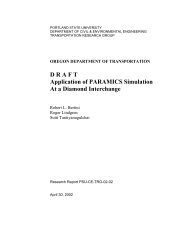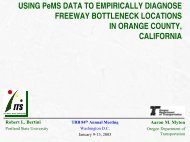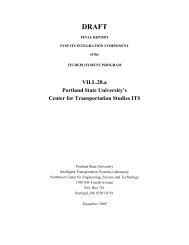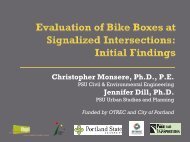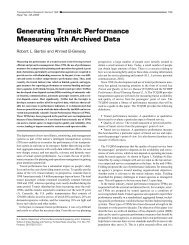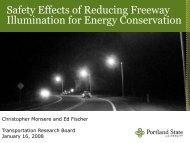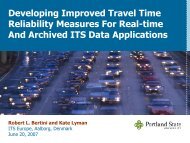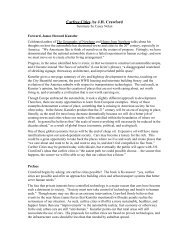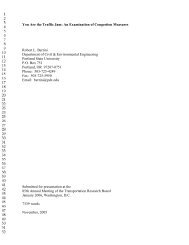Application of Paramics Simulation to a Diamond Interchange
Application of Paramics Simulation to a Diamond Interchange
Application of Paramics Simulation to a Diamond Interchange
Create successful ePaper yourself
Turn your PDF publications into a flip-book with our unique Google optimized e-Paper software.
<strong>Application</strong> <strong>of</strong> PARAMICS <strong>Simulation</strong> at a <strong>Diamond</strong> <strong>Interchange</strong> Page 2<br />
One strength <strong>of</strong> modern simulation models is that they are based on the random movements<br />
<strong>of</strong> each vehicle. This discrete modeling provides the opportunity <strong>to</strong> view the animated<br />
vehicles on a graphical representation <strong>of</strong> the network. In addition, microscopic traffic<br />
simulation models do not need <strong>to</strong> explicitly model such behavior as queueing, vehicle<br />
pla<strong>to</strong>ons, or shock waves. These situations occur in the simulation for the same reason they<br />
occur on the actual road networks, that is because they are natural consequences <strong>of</strong> the<br />
interaction <strong>of</strong> drivers, vehicles, road geometry and traffic control mechanisms. (2)<br />
The objective <strong>of</strong> this paper is <strong>to</strong> investigate the traffic engineering applications <strong>of</strong> Quads<strong>to</strong>ne<br />
PARAMICS, a popular microscopic traffic simulation model, at a particular site in Oregon.<br />
The Oregon Department <strong>of</strong> Transportation (ODOT) purchased the simulation s<strong>of</strong>tware in<br />
exchange for documentation <strong>of</strong> research experience gained by Portland State University’s<br />
Transportation Research Group.<br />
The study site consists <strong>of</strong> the area surrounding the diamond interchange <strong>of</strong> Interstate 5 (I-5)<br />
and Wilsonville Road, located in the city <strong>of</strong> Wilsonville, Oregon. Figure 1 shows the location<br />
<strong>of</strong> the study area. This interchange is characterized by high traffic volumes (80,000 average<br />
daily traffic—ADT—on I-5) and heavy peak hour traffic <strong>to</strong> and from the City <strong>of</strong> Wilsonville.<br />
The study described herein details the key features <strong>of</strong> the PARAMICS s<strong>of</strong>tware package,<br />
reports on actual modeling experience and evaluates its effectiveness in modeling a diamond<br />
interchange and several adjacent intersections.<br />
The next section <strong>of</strong> this report summarizes some <strong>of</strong> the recent literature related <strong>to</strong><br />
microscopic simulation <strong>of</strong> urban and freeway traffic. This is followed by a description <strong>of</strong> the<br />
PARAMICS s<strong>of</strong>tware package. Descriptions <strong>of</strong> the network and the data collection phases <strong>of</strong><br />
the project are then presented. Next, the model implementation stages, from network coding<br />
<strong>to</strong> model calibration and validation are discussed. Finally, the report ends with a review <strong>of</strong><br />
the major findings and a list <strong>of</strong> <strong>to</strong>pics requiring future research.<br />
BACKGROUND<br />
There are many microscopic traffic simulation models currently being used for research and<br />
practical purposes worldwide. The European Commission’s Transport Research and<br />
Technological Development program recently completed an assessment <strong>of</strong> current traffic<br />
microscopic simulation <strong>to</strong>ols. As shown in Table 2, the Commission’s research revealed the<br />
availability <strong>of</strong> 57 models, and categorized them by the traffic situation they are designed <strong>to</strong><br />
model, namely urban, freeway, urban and freeway, au<strong>to</strong>mated highway systems (AHS) or<br />
Other. (3)<br />
Portland State University Transportation Research Group 2002



